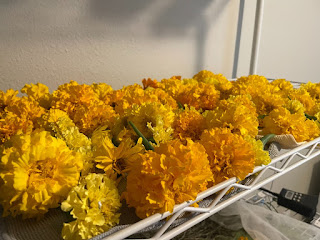11/24/2023
From the Office of
Grass to Veggies
FOR
IMMEDIATE RELEASE
Contact: James Lissy | info@grasstoveggies.com | www.grasstoveggies.com | Longmont, CO
Re:
Boulder County Proposed Integrated Weed Management Plan
 |
| Earthrise from the moon – Apollo 8 – Photo by Bill Anders. “The Earth from here is a grand oasis in the big vastness of space.” – Jim Lovell |
As
a resident of Boulder County, the county’s proposed integrated weed management
proposal is appalling due to its emphasis on using, over-using and unchecked
use of chemicals which pose a significant threat to human health, pollinators,
water quality, aquatic life, soil and overall health of the environment. The lack of pro-active notification to the
community regarding this plan, lack of emphasis on indigenous / regenerative
agriculture for weed control, lack of consideration of modern science and lack
of scientific monitoring when chemicals are used make this proposed plan highly
unacceptable.
I
understand that the County wants the easy button when it comes to weed
control. The County wants to be able to
suppress the undesirable weeds as easily and efficiently as possible. However, the effects that the chemicals have
on everything else in the environment is blatantly ignored in this proposed
plan. At the bottom of this letter, you
will find a list of scientific articles that walk you through the actual
effects that these chemicals have on the environment as a whole. While a lot of these chemicals do effectively
kill the targeted species and some are certainly more harmful than others, the
majority of these chemicals have drastic and unknown consequences on the rest
of the environment as a whole. These are
extremely important considerations since these chemicals can have negative
effects on desirable plants species, pollinators, soil health, water quality,
aquatic health, endangered species, and us humans. Not to mention that the increasing resistance
to chemicals in the targeted weed species has been noted in several studies
which hints at chemicals that are currently effective will likely not be
effective in the future.
As
you read through the actual scientific and independent research a few things
become abundantly clear. Governing
agencies and society as a whole generally consider these chemicals to be safe
until proven otherwise. Even after the
chemicals have been proven to not be safe, the new peer reviewed scientific
papers done by independent scientists with independent funding gets rejected
and ignored by governing agencies within the US, such as the Environmental
Protection Agency (EPA). The only
“science” that the EPA currently evaluates is what is submitted by the company
that manufactures the chemical when they first submit an application to the
EPA. These companies stand to make
billions of dollars in profit if their applications are approved by the EPA
which is an obvious and clear conflict of interest. Most governing bodies outside of the US peer
review submitted research to either verify or dismiss the submitted research
which makes governing bodies outside of the US currently much more reliable for
determining harm levels of chemicals.
The majority of these chemicals have adverse effects on plants, worms,
soil, fish, aquatic life, and seed production of desirable plants. These negative effects of chemicals are
normally not discovered until well after the wide use of the chemicals, making
the damage already done. Paper after
paper cites lacks of research or notes that more research is needed into
specific and potentially harmful aspects of chemical use. When research is done on effects of
pollinators, this research is usually limited to honey bees. This limited research is absurd for a few
notable reasons: Bees in general are not
the only pollinators and are only a portion of all overall pollinators. Honey bees are not native to the US and there
are a lot of native bee species in the US which are commonly referred to as
native bees. Native bees are extremely
important to the ecosystem since they have adapted to live here naturally,
without human assistance. Chemical
effects on native bees have not been researched. A lot of these native bees are solitary, do
not live in hives and live underground or in brush on the ground making them
more susceptible to the potential effects of chemicals. Furthermore, pollinators in general have a
wide range of foraging which also makes them more susceptible to chemical use
even if the chemicals are not sprayed directly on them. Chemical effects on soil and water health are
often overlooked and it is routinely discovered that chemicals once touted as
safe have drastic negative effects on soil and water health.


